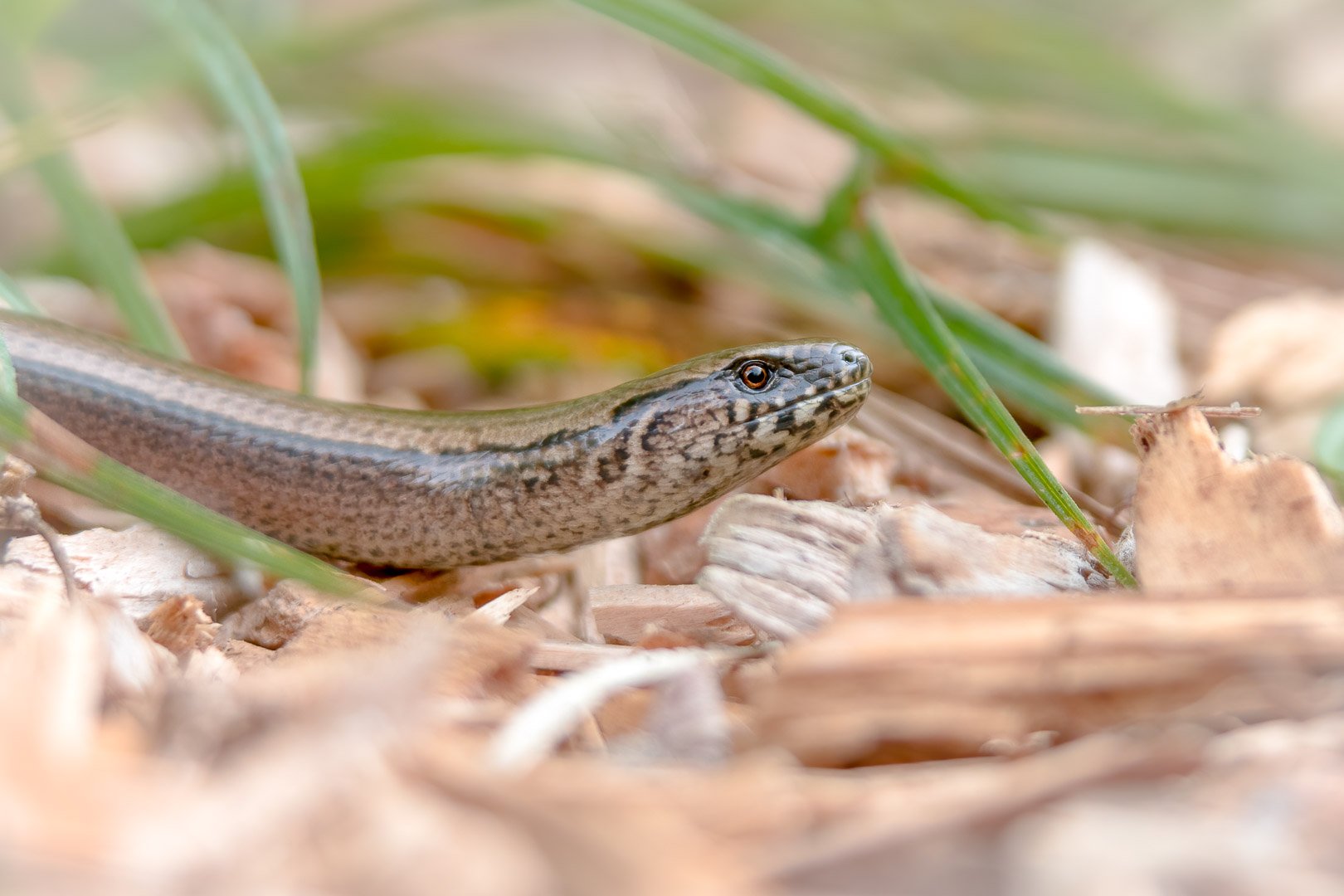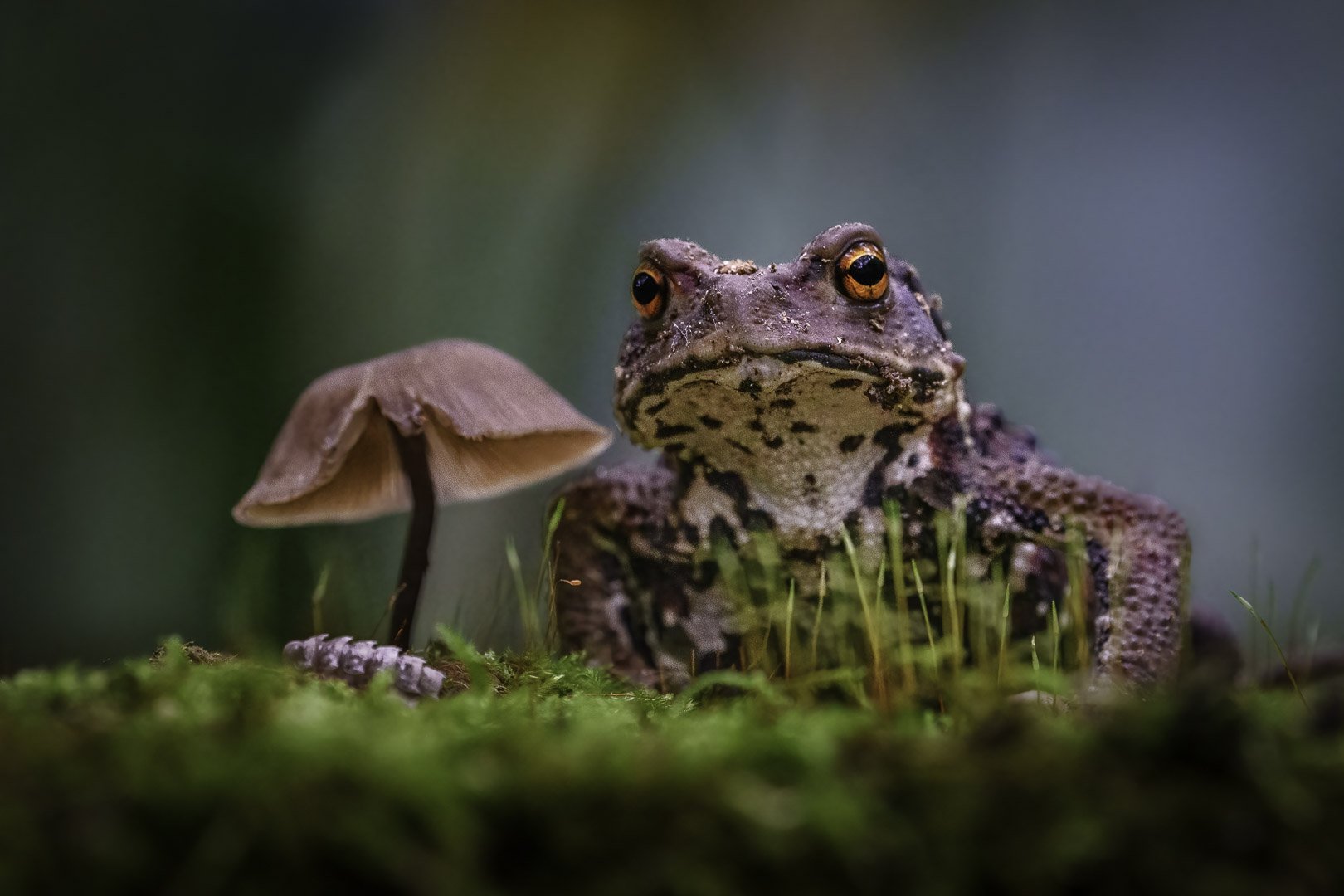Slow worm (Anguis fragilis)
Slowworm (Anguis fragilis) - Picture taken in the Upper Palatinate, Bavaria
Key Facts
Size: 40 - 57.5 cm
Weight: 50 - 100 g
Diet: Snails, earthworms, insects
Season: All year round in all of Germany
Observation Tip: Forests, fields, gardens, heathlands
Photography Tips:
Lens: Starting from 100 mm
Difficulty Level: Easy
Introduction
The western slow worm, scientifically known as Anguis fragilis, is a species of lizard belonging to the family Anguidae. It is one of the most common reptiles in Central Europe. Due to its legless, elongated body, it is often mistaken for a snake, which is even reflected in its scientific name given by Carl Linnaeus. The genus name "Anguis" is Latin for "snake," while the species name "fragilis" means "fragile." Despite its resemblance to snakes, there are important distinguishing features. Slowworms have movable eyelids and external ear openings, although covered by scales. Another notable characteristic is their ability to shed their tail to protect themselves from predators.
Misconceptions
A common misconception is that the lowworm (Anguis fragilis) is blind because of its name. In reality, the name is often traced back in the literature to Old High German "plintslîcho," which is generally translated as "blinding" or "shining slowworm." This refers to the shiny appearance of the smooth scalation and the typical movement of the slowworm.
Recognition and Protection
In 2017, the lowworm (Anguis fragilis) was named Reptile of the Year by the German Society for Herpetology and Herpetoculture.
Physical Characteristics
Slowworms have a circular, elongated body without extremities and can grow up to 57.5 cm long, although most adults are between 40 and 45 cm. The head is relatively small and high, merging directly into the body, while the tail ends in a horny tip and is often slightly longer than the body. Many slowworms can easily shed their tails at several points, resulting in a significant portion of the population lacking a full tail. Only a short, hemispherical stump remains, and the missing tail section does not regenerate. Therefore, the head-body length is preferred for measuring slowworms. The cloaca of the lowworm (Anguis fragilis) has a transverse slit.
Sexual Dimorphism
Male and female slowworms can be distinguished by several characteristics, though not always clearly. Male slowworms have two eversible hemipenes as a primary sexual characteristic, and their heads are somewhat broader with larger pileus shields. In contrast, the longest and heaviest slowworms are usually female. Pregnant females have a thickened body compared to the tail. In terms of coloration, females often retain juvenile features such as the dorsal stripe and sharp color boundary on the flanks with a darker underside. Male slowworms often lack a dorsal stripe and appear more uniformly colored.
Distribution
The distribution of the (Western) slowworm has been found to be smaller than previously thought, following the reclassification of several species. The large range of Anguis colchica in Eastern Europe, extending from southern Finland through the Baltic region and western Russia to the Black Sea and further over the Caucasus to the southern coast of the Caspian Sea, is now considered part of another species and is no longer part of the Western slowworm's range. Likewise, large parts of Italy and Greece are no longer included in this range. The remaining distribution of Anguis fragilis extends from northern Spain through France and Germany to eastern Central Europe and the Balkans. In the north, Denmark, the UK, southern Norway, and southern to parts of central Sweden are inhabited. The contact and transition zone between the ranges of the Western and Eastern slowworms roughly runs from Kaliningrad southward. In some countries such as Poland, the Czech Republic, Slovakia, Hungary, and Romania, both species occur. Slowworms in German-speaking regions belong exclusively to the Western species, while the Italian slowworm occurs in Ticino (Switzerland).
Habitat
The low worm (Anguis fragilis) is a eurytopic species, meaning it can utilize a variety of biomes without particular specialization. Preferred habitats include dense deciduous forests and their edges, hedges, bogs, meadows, fallow lands, parks, and natural gardens. It prefers areas with dense herbaceous vegetation and some soil moisture. Unlike many other reptiles, the slowworm is not very thermophilic. It often shares its habitats with other reptiles such as the common lizard, adder, smooth snake, and sand lizard. Slowworms frequently use dry sunbathing spots like deadwood, dark humus soil, old grass clumps, and hiding places such as burrows, cavities under tree roots, fallen logs, stones, rock crevices, moss cushions, leaf and compost piles, and wood stacks. Several animals often gather at particularly favorable hiding spots.
Hibernation
Slowworms spend the winter in a state of torpor in frost-protected hiding places. They often dig underground tunnels 15 to 100 cm long and seal them with moss or earth. They frequently hibernate in groups of 5 to 30 animals, sometimes even in groups of over 100 individuals. Older animals seem to stay at greater depths, while younger ones stay closer to the entrance. It has even been observed that slowworms hibernate together with their predators, such as snakes. In Central Europe, most slowworms retreat to their hiding places in October and usually re-emerge in March or early April when conditions allow.
Activity and Diet
Slowworms are mainly diurnal and hunt primarily slugs, earthworms, and hairless caterpillars. Their backward-curved teeth help them hold onto these prey items. They also eat woodlice, millipedes, grasshoppers, beetles and their larvae, aphids, cicadas, ants, and small spiders. Among snails, they primarily consume field slugs and smaller specimens of large black slugs. Slowworms are not blind but have limited vision and are colorblind. They rely primarily on their sense of smell and touch, which play a crucial role in hunting. The prey is grabbed and swallowed whole, a process that can take up to half an hour for larger earthworms. Slowworms are also found outside their hiding places, especially in humid, mild weather, such as before thunderstorms or in warm drizzle, and possibly even on very mild summer nights.


